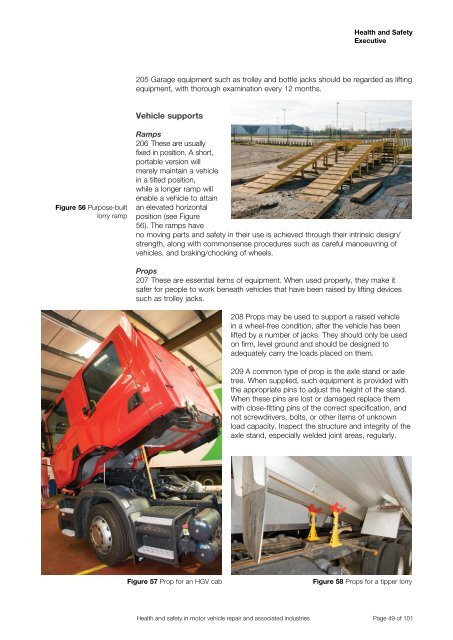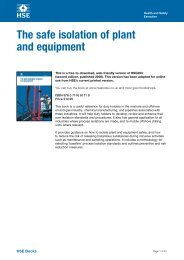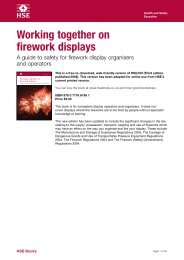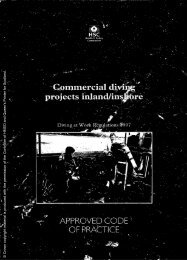Health and safety in motor vehicle repair and associated industries
Health and safety in motor vehicle repair and associated industries
Health and safety in motor vehicle repair and associated industries
You also want an ePaper? Increase the reach of your titles
YUMPU automatically turns print PDFs into web optimized ePapers that Google loves.
Figure 56 Purpose-built<br />
lorry ramp<br />
<strong>Health</strong> <strong>and</strong> Safety<br />
Executive<br />
205 Garage equipment such as trolley <strong>and</strong> bottle jacks should be regarded as lift<strong>in</strong>g<br />
equipment, with thorough exam<strong>in</strong>ation every 12 months.<br />
Vehicle supports<br />
Ramps<br />
206 These are usually<br />
fixed <strong>in</strong> position. A short,<br />
portable version will<br />
merely ma<strong>in</strong>ta<strong>in</strong> a <strong>vehicle</strong><br />
<strong>in</strong> a tilted position,<br />
while a longer ramp will<br />
enable a <strong>vehicle</strong> to atta<strong>in</strong><br />
an elevated horizontal<br />
position (see Figure<br />
56). The ramps have<br />
no mov<strong>in</strong>g parts <strong>and</strong> <strong>safety</strong> <strong>in</strong> their use is achieved through their <strong>in</strong>tr<strong>in</strong>sic design/<br />
strength, along with commonsense procedures such as careful manoeuvr<strong>in</strong>g of<br />
<strong>vehicle</strong>s, <strong>and</strong> brak<strong>in</strong>g/chock<strong>in</strong>g of wheels.<br />
Props<br />
207 These are essential items of equipment. When used properly, they make it<br />
safer for people to work beneath <strong>vehicle</strong>s that have been raised by lift<strong>in</strong>g devices<br />
such as trolley jacks.<br />
208 Props may be used to support a raised <strong>vehicle</strong><br />
<strong>in</strong> a wheel-free condition, after the <strong>vehicle</strong> has been<br />
lifted by a number of jacks. They should only be used<br />
on firm, level ground <strong>and</strong> should be designed to<br />
adequately carry the loads placed on them.<br />
209 A common type of prop is the axle st<strong>and</strong> or axle<br />
tree. When supplied, such equipment is provided with<br />
the appropriate p<strong>in</strong>s to adjust the height of the st<strong>and</strong>.<br />
When these p<strong>in</strong>s are lost or damaged replace them<br />
with close-fitt<strong>in</strong>g p<strong>in</strong>s of the correct specification, <strong>and</strong><br />
not screwdrivers, bolts, or other items of unknown<br />
load capacity. Inspect the structure <strong>and</strong> <strong>in</strong>tegrity of the<br />
axle st<strong>and</strong>, especially welded jo<strong>in</strong>t areas, regularly.<br />
Figure 57 Prop for an HGV cab Figure 58 Props for a tipper lorry<br />
<strong>Health</strong> <strong>and</strong> <strong>safety</strong> <strong>in</strong> <strong>motor</strong> <strong>vehicle</strong> <strong>repair</strong> <strong>and</strong> <strong>associated</strong> <strong>in</strong>dustries Page 49 of 101







